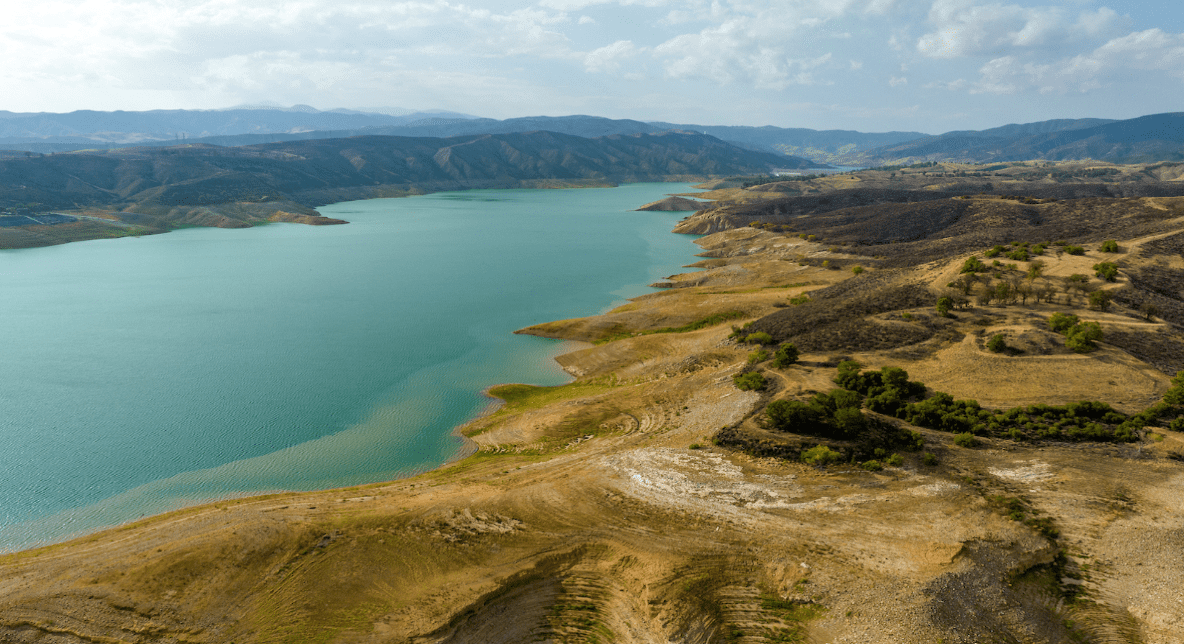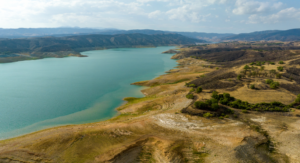Opinion: Claremont should get serious about drought, at home and ballot box

A drone photo of Castaic Lake taken September 13. Photo/courtesy of California Water Watch.
by Mallorie Jenne and Journey Lipscom
For a town known as “the City of Trees and Ph.Ds.,” Claremont’s greenspace lives up to its namesake and is a source of pride for longtime community members. Trees line our roads, sagebrush rims the San Gabriels, and the Claremont Colleges flaunt lush green quads.
However, our easy access to thriving natural spaces is a double-edged sword. In a City of Trees, we’re susceptible to slipping into a false sense of water security — and Claremont’s emphasis on greenery doesn’t reflect the reality of California’s water crisis.
Ten minutes down Foothill Boulevard, dirt-lined sidewalks and brown grass are constant reminders of impending water scarcity in California. Claremont, in contrast, doesn’t appear to be as well-acclimated to the increasingly dry climate. We’re living in a drought, and we need to adapt our landscape and habits accordingly.
This isn’t just any drought, either. California is experiencing its driest period in thousands of years. State reservoirs are at critically low levels, currently averaging 68% of their usual capacity. If you’ve ever driven down the Grapevine, you might have seen Castaic Lake, one of California’s largest reservoirs, located near Six Flags. Castaic’s receding water levels are visible from the 5 Freeway and serve as a striking example of the severity of the water crisis.

A drone photo of Castaic Lake taken September 13. Photo/courtesy of California Water Watch.
These dry conditions are so chronic scientists have begun opting for the term “aridification” over “drought.” Aridification describes an inevitable state of increasing dryness that occurs because of human-induced climate change. Don’t let a November rain spell fool you: a study by scholars at Stanford revealed that regardless of precipitation trends, the risk of ongoing drought is already high due to anthropogenic warming.
Although aridification will continue throughout our lifetimes, we have the power to adopt new strategies, elect water-conscious leaders, and improve the future of water security for ourselves, our city, and our state.
Aridification may seem distant when your grass is green and the neighbor’s pool is full, but that doesn’t make its impacts less relevant. Beyond causing longer dry seasons and impacting reservoir levels, the IPCC reports droughts will affect agriculture and put food security at risk. The drier ground will also make us more vulnerable to severe wildfires and extreme heat events. Claremont residents aren’t responsible for managing all of California’s water, but adapting as a community can help us make the most of the water we do have.
More Californians are finding ways to reduce their water usage, but we aren’t on target yet. After water restrictions relaxed following the drought in 2015, reduced water consumption continued, which was a promising sign. Claremont residents must continue best water conservation practices to meet the water new savings target outlined in the mandatory water reductions implemented earlier this year. Installing water saving devices in your home like efficient toilets, washing machines, shower heads, and dishwashers can save gallons of water. As a bonus, SoCal Water$martprovides rebates for high efficiency toilets and clothes washers.
You can also get rebates for replacing the turf in your yard. Claremont’s guide to installing drought-tolerant landscaping provides information on how to build a thriving front yard with native plants. These plants require less water, can produce shade to facilitate a healthy yard ecosystem, and are often quite striking as well. Using less water for turf lawns means we will also have water to preserve Claremont’s beloved trees. Now is the perfect time to take advantage of these rebate programs and rethink your landscaping at home.
There’s nothing wrong with enjoying the greenspace Claremont’s trees offer, but we can’t let it disillusion us. Aridification requires us to take immediate action if we hope to maintain a healthy and livable habitat in years to come. Beyond our household efforts, we need to elect water-wise officials who will bring a climate-forward approach to local water policy. This week, Jeff Hanlon is giving us an opportunity. Hanlon is running for Three Valleys Municipal Water District, where he plans to prioritize local climate change adaptation efforts through wastewater recycling, stormwater capture, and user conservation. Read more about his platform and keep aridification in mind on November 8 — the City of Trees is counting on you.
Mallorie Jenne is a senior at Harvey Mudd College and Journey Lipscomb is a junior at Pitzer College.









0 Comments